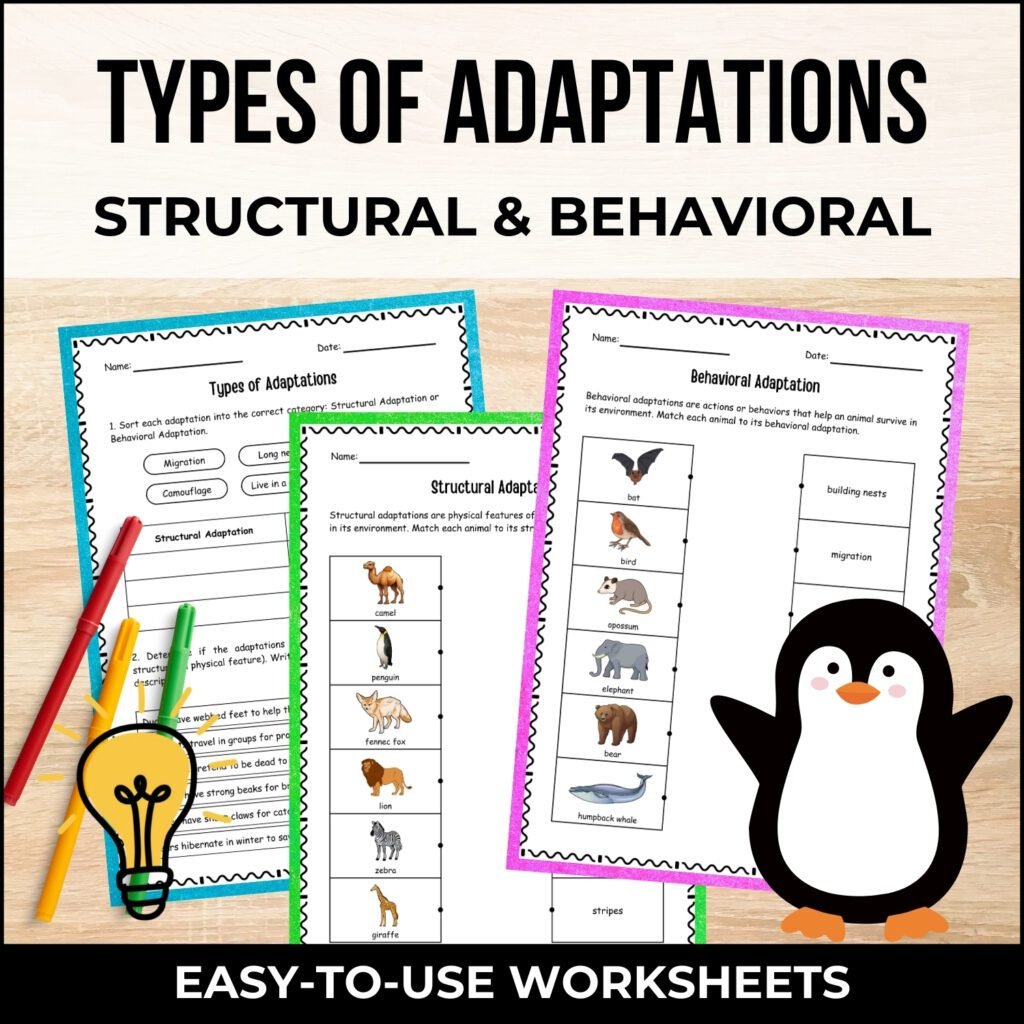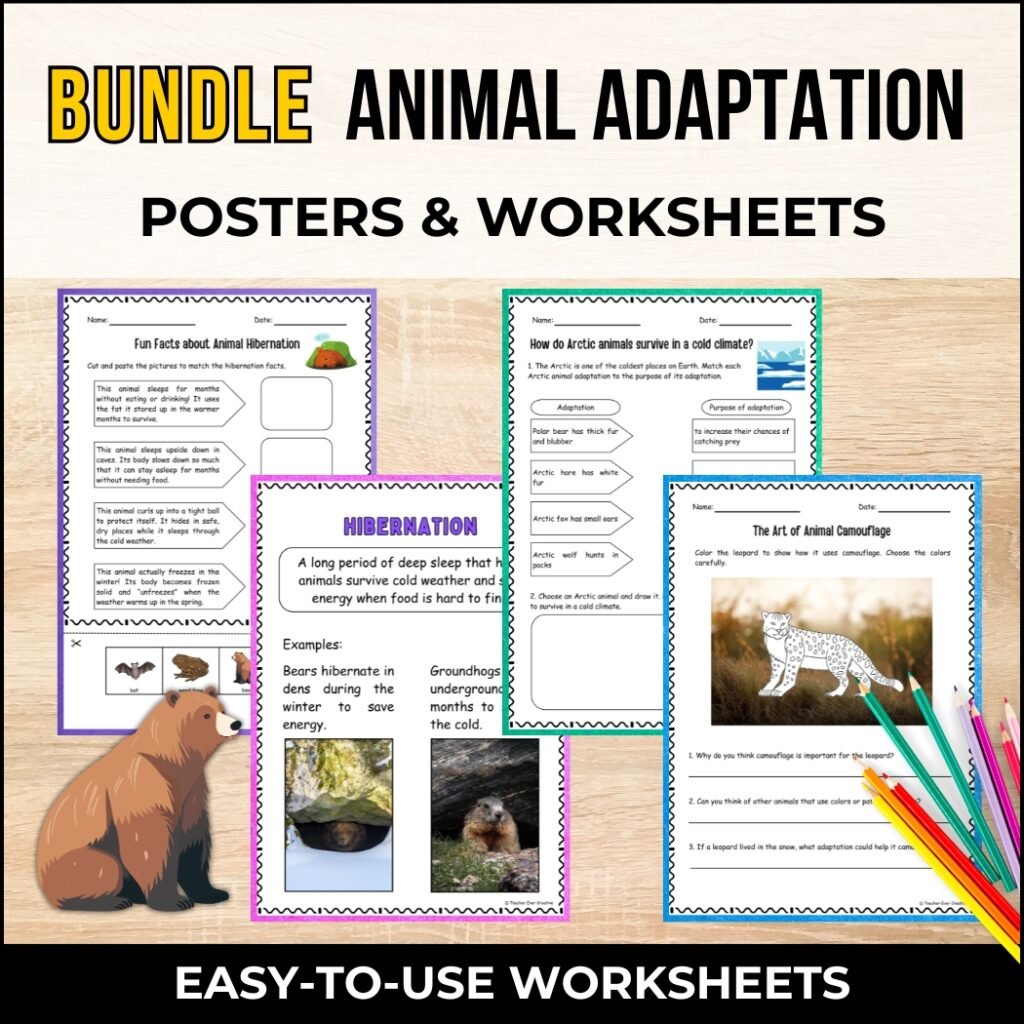Teaching structural and behavioral adaptations is one of those lessons that can either be really exciting or really confusing for kids. Some students get it right away—“Oh! A penguin’s blubber keeps it warm!”—while others struggle with the difference between what an animal has (structural) and what it does (behavioral).
If you’re looking for engaging ways to make this lesson stick, you’re in the right place. I’ll walk you through how to explain adaptations, common student challenges, and fun activities that’ll get your class excited about how animals survive in the wild.
1. Start with Curiosity
The best way to hook students? Show, don’t tell.
Project a few pictures of different animals—maybe a penguin, a fennec fox, and a zebra. Ask students:
👉 What do you notice about these animals?
👉 What stands out about their bodies?
👉 How do you think these features help them survive?
Let them describe what they see. Some might point out a zebra’s stripes, a fox’s big ears, or a penguin’s thick feathers. Encourage them to ask questions—until they naturally start wondering things like:
•Why do zebras have stripes?
•Why do some animals have big ears while others have tiny ones?
•How do penguins stay warm in freezing temperatures?
Now you’ve got them thinking like scientists. From here, guide them into the concept of adaptations—how animals survive in their environments through both physical traits and behavioral strategies.
2. Understanding Structural vs. Behavioral Adaptations
Here’s where things can get tricky. Some kids mix up structural and behavioral adaptations, especially when it comes to things like camouflage or mimicry.
Structural Adaptations (What an animal has)
These are physical features that help animals survive. Here are a few fun examples to use in class:
🎭 Camouflage – Helps animals blend in.
•Stick insects look like twigs.
•Leopards’ spots help them disappear in tall grass.
🐍 Mimicry – Looking like something else for protection.
•Viceroy butterflies mimic monarchs to avoid predators.
•Milk snakes copy the coloring of venomous coral snakes.
🌡 Temperature Control – Keeping warm or cool.
•Polar bears have thick fur and blubber.
•Fennec foxes have large ears that release heat.
Behavioral Adaptations (What an animal does)
These are actions animals take to survive.
🛫 Migration – Moving to a better environment.
•Monarch butterflies fly thousands of miles to escape winter.
•Geese fly south in V-formations to conserve energy.
💤 Hibernation – Saving energy during tough seasons.
•Bears sleep through winter to survive cold months.
•Ground squirrels hibernate underground where it’s warmer.
🎭 Deceptive Behavior – Tricking predators.
•Opossums “play dead” when threatened.
•Hognose snakes flip onto their backs and pretend to be lifeless.
💡 Quick Tip: Some students think camouflage is a behavior (because an animal is “choosing” to blend in). Make it clear that camouflage is a physical trait—not something the animal actively does.
3. Engaging Activities to Teach Adaptations
Here’s where the fun starts. These activities get students thinking, moving, and engaged.
A. Adaptation Sorting Game
Print out pictures of different animals and their adaptations. Have students sort them into two categories: structural or behavioral adaptations.
👉 Want to make it harder? Include a few tricky ones (like camouflage or mimicry) and discuss why they belong in the structural category.
B. Create Your Own Adapted Animal
Have students design a brand-new animal suited for an extreme environment. They must include:
✔ Two structural adaptations (like thick fur or webbed feet).
✔ Two behavioral adaptations (like migration or burrowing).
Then, they can draw their animal and explain its adaptations to the class. This one’s always a hit!
C. Act It Out: Adaptation Role-Play
Give students different animals and ask them to act out their adaptations while the class guesses. Examples:
•A turtle pulling into its shell.
•A chameleon “blending” into its surroundings.
•A bear “hibernating” (a.k.a. lying on the floor pretending to sleep).
It gets ridiculous, but that’s what makes it fun—and memorable.
4. Common Student Challenges & How to Help
Some kids struggle with the vocabulary in this unit. Words like mimicry, adaptation, hibernation can feel overwhelming, especially for younger learners.
One way to help? Visual aids. A science bulletin board with Animal Adaptation Vocabulary Posters can serve as a quick-reference tool during discussions. These posters include clear definitions, real-world examples, and fun review activities like a matching game, crossword puzzle, and classification chart. The best part? The classification chart helps students differentiate between structural and behavioral adaptations, and they can glue it into their notebooks for future reference.
You can grab ready-to-use adaptation posters and activities HERE.
5. How to Check for Understanding
✔ Exit Ticket: Ask students to name one structural and one behavioral adaptation of an animal they choose.
✔ Class Discussion: “Would a penguin survive in the desert? Why or why not?”
✔ Digital Quiz: Use Kahoot or Quizizz to make review time feel like a game.
Final Thoughts
Teaching structural and behavioral adaptations doesn’t have to be a boring lecture. Get students asking questions, sorting examples, acting things out, and creating their own adapted creatures. The more hands-on you make it, the more they’ll remember.
And if you’re looking for time-saving resources to reinforce these concepts, check out the Animal Adaptation BUNDLE here. They’re great as independent practice, classwork and supplemental resource.











